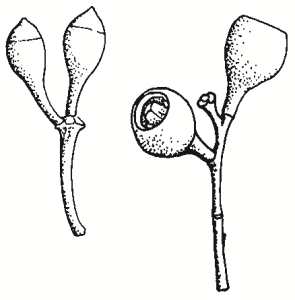Family:
Myrtaceae
Eucalyptus polyanthemos
Red Box
Other Names:

Name Origin:
polyanthemos — from Greek poly, many, and anthemon, flower, referring to the many flower buds in each panicle.
Regional Subspecies:
E. polyanthemos subsp. polyanthemos; E. polyanthemos subsp. vestita
Occurrence:
Regional:
Widespread in most catchments and districts on slopes and rises.
Australia:
NSW, Vic.
Habitat:
Grassy or sclerophyll woodland on light, shallow soils.
Habit:
Tree to 20 m high with short trunk and dense spreading crown of rounded dull grey-green or blue-green leaves. ‘Box’ bark on trunk and larger branches.
Site Preference:
Well-drained soil. Tolerates frost and wind. Moderately drought tolerant.
Characteristics:
Moderate growth rate.
Flowering:
White, cream or pinkish, Sep-Dec. Profuse.
Seed Collection:
Early Mar to late Jun. Monitor seed-bearing capsules as seeds shed after maturity.
Propagation:
From seed (± 465 viable seeds per gram). Optimum germination temperature 32°C.
Regeneration:
From seed, particularly in absence of competitive exotic grasses or weeds, during wet summers. Regenerates well from lignotuber after fire, browsing or cutting. Establishes when direct seeded, but not vigorously.
VALUES:
Shade & Shelter:
Useful medium-level cover in windbreaks. Useful shade due to large spreading crown.
Land Protection:
Useful for recharge areas as uses large volumes of ground-water.
Wildlife:
Excellent habitat. Flowers are a nectar source for various native birds and insects. Insect-eating birds attracted. Birds such as treecreepers and sittellas glean bark. Native birds eat seeds and fruits. Koalas occasionally eat foliage. Hollows are nesting sites for various native birds and mammals.
Fuel:
Excellent.
Timber:
Red, fine-textured, interlocked grain. Hard, strong and durable. Density about 1020 kg/m3. Dries slowly. Difficult to season. Used in fencing, turning, and for poles. Apparently moderately termite resistant. Suitable woodlot species for firewood (coppices readily) and sawn farm timber. Suitable for high value knot-free furniture timber if planted at high densities and regularly pruned.
Ornamental:
Shapely, attractive specimen, shade and street tree.
Other:
Leaves produce range of dyes depending on mordants used. Leaves high in cineole, useful in medicine. In America and France, grown for producing cut foliage for cut flower trade.
